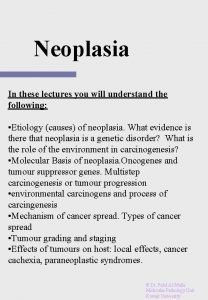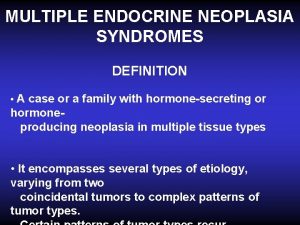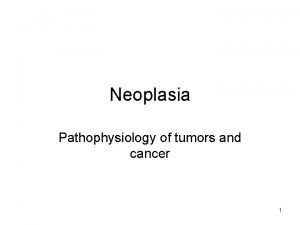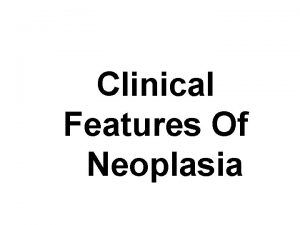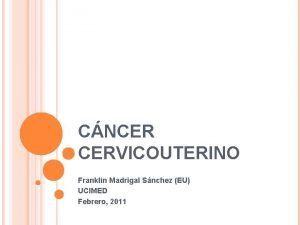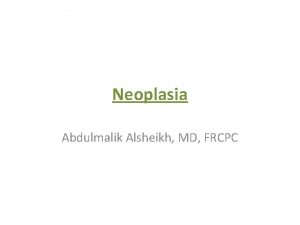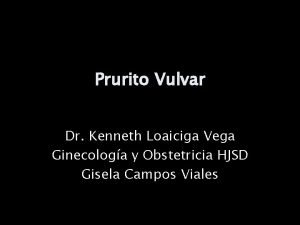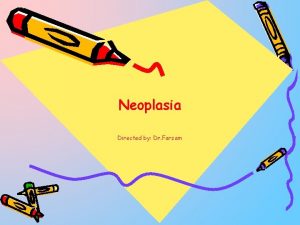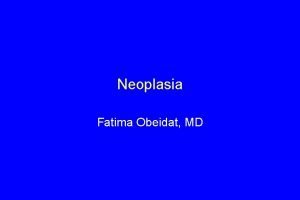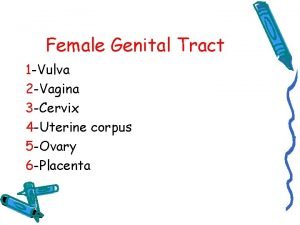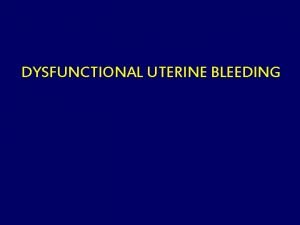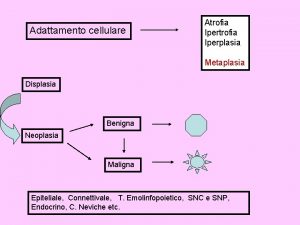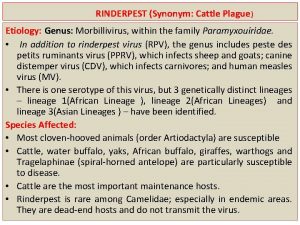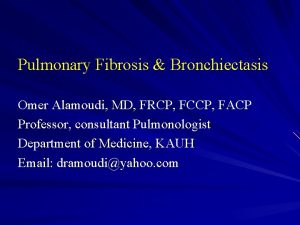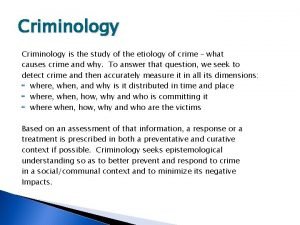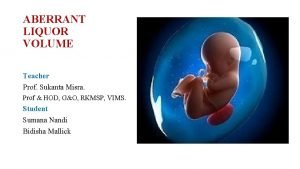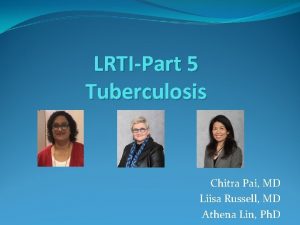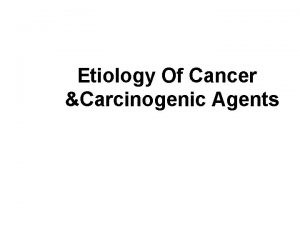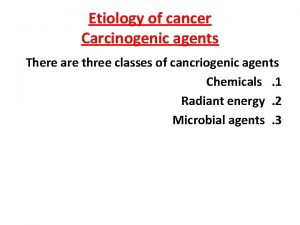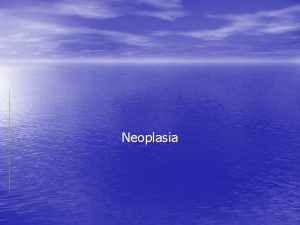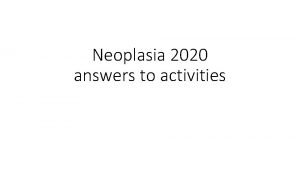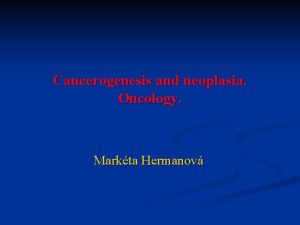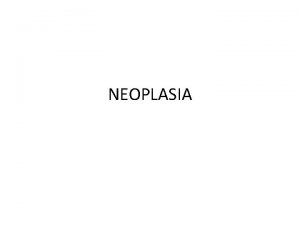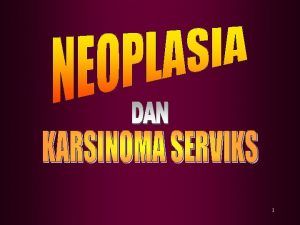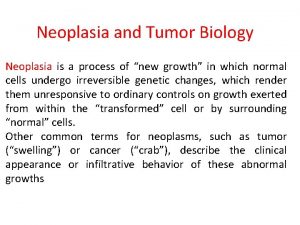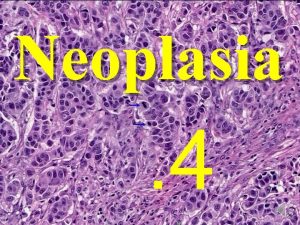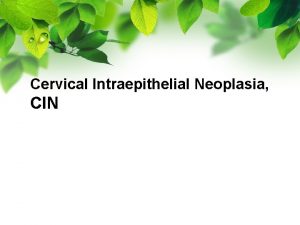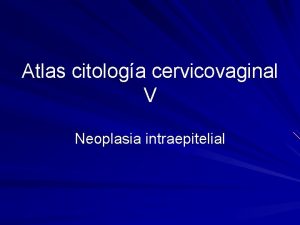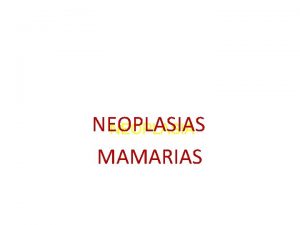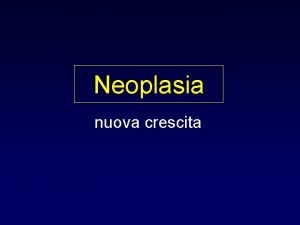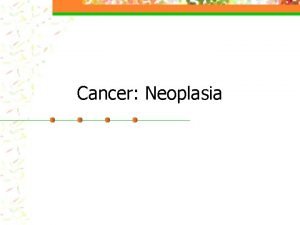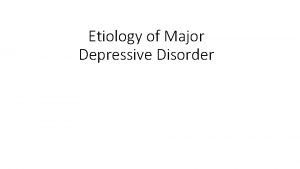NEOPLASIA Lecture 3 ETIOLOGY OF CANCER CARCINOGENIC AGENTS





























- Slides: 29

NEOPLASIA Lecture 3 ETIOLOGY OF CANCER: CARCINOGENIC AGENTS Maha Arafah, MD, KSFP Abdulmalik Alsheikh, M. D, FRCPC Foundation block 2014 Pathology

Objectives n List the various causes of neoplasms

Carcinogenic Agents Chemicals n Radiation n Microbial agents n

Carcinogenic Agents Chemical Carcinogens Natural or synthetic n Direct reacting or indirect n Indirect need metabolic conversion to be active and carcinogenic n Indirect chemicals are called “ procarcinogens “ and their active end products are called “ ultimate carcinogens” n


Carcinogenic Agents Chemical Carcinogens All direct reacting and ultimate chemical carcinogens are highly reactive as they have electron-deficient atoms n They react with the electron rich atoms in RNA, DNA and other cellular proteins n

Carcinogenic Agents Chemical Carcinogens n Examples: Alkylating agents n Polycyclic hydrocarbons: n n Cigarette smoking n Animal fats during broiling meats n Smoked meats and fish

Carcinogenic Agents Chemical Carcinogens n Aromatic amines and azo dyes: B-naphthylamine cause bladder cancer in rubber industries and aniline dye n Some azo dyes are used to color food also can cause bladder cancer n

Carcinogenic Agents Chemical Carcinogens n Other sustances: Nitrosamines and nitrosamides are used as preservatives. They cause gastric cancer. n Aflatoxin B: produced by Aspergillus growing on improperly stored grains. It cause hepatocellular carcinoma n

Carcinogenic Agents Chemical Carcinogens n Mechanism of action of chemical carcinogens: Most of them are mutagenic. i. e. cause mutations n RAS and P 53 are common targets n

Carcinogenic Agents Radiation Carcinogenesis UV rays of sunlight n X-rays n Nuclear radiation n Therapeutic irradiations n n Radiation has mutagenic effects: chromosomes breakage, translocations, and point mutations

Carcinogenic Agents Radiation Carcinogenesis n UV rays of sunlight : Can cause skin cancers: melanoma, squamous cell carcinoma, and basal cell carcinoma n It is capable to damage DNA n With extensive exposure to sunlight, the repair system is overwhelmed skin cancer n They cause mutations in P 53 gene n

Carcinogenic Agents n Viral and Microbial oncogenesis n DNA viruses n RNA viruses n other organisms

Carcinogenic Agents Viral Carcinogenesis carry genes that induce cell replication as part of the viral life cycle n host cell has endogenous genes that maintain the normal cell-cycle n Viral infection mimics or blocks these normal cellular signals necessary for growth regulation n

Carcinogenic Agents Viral Carcinogenesis RNA Oncogenic viruses Human T-Cell Leukemia Virus type 1 (HTLV-1) • RNA retrovirus targets / transforms T-cells • causes T-Cell leukemia/Lymphoma • Endemic in Japan and Caribbean • Transmitted like HIV but only 1% of infected develop TCell leukemia/Lymphoma • 20 -30 year latent period No cure or vaccine Treatment : chemotherapy with common relapse n n


Carcinogenic Agents Viral Carcinogenesis DNA Oncogenic Viruses virus DNA forms stable association with host’s DNA n transcribed viral DNA transforms host cell n Examples: (HPV) Human papilloma viruses Epstein-Barr (EBV) Hepatitis B (HBV) Kaposi sarcoma herpes virus

Carcinogenic Agents Human Papillomavirus (HPV) n HPV causing benign tumors: n types 6, 11

Carcinogenic Agents Viral Carcinogenesis Human Papillomavirus (HPV) • 70 types • squamous cell carcinoma of cervix n anogenital region n mouth n larynx n

Carcinogenic Agents Human Papillomavirus (HPV) n sexually transmitted n Cervical cancer n 85% n Genital n types have types 16 and 18 warts 6 and 11

Carcinogenic Agents Human Papillomavirus (HPV) n HPV causing malignant tumors : n types 16, 18, 31 n v. DNA integrates w/ host

Carcinogenic Agents Viral Carcinogenesis n HPV (types 16 and 18) n over-expression of Exon 6 and 7 n E 6 protein binds to Rb tumor suppressor n replaces normal transcription factors n decreases Rb synthesis n E 7 protein binds to P 53 n facilitates degradation of P 53

Carcinogenic Agents Viral Carcinogenesis n HPV infection alone is not sufficient n other risk factors: n cigarette smoking n coexisting n hormonal infections changes

Carcinogenic Agents Viral Carcinogenesis n Epstein-Barr Virus • common virus worldwide Infects B lymphocytes and epithelial cells of oropharynx • • • causes infectious mononucleosis EBV infection may cause malignancy n Burkitt’s Lymphoma n B cell lymphoma in immunosuppressed n Nasopharyngeal carcinoma

Carcinogenic Agents Viral Carcinogenesis Epstein-Barr Virus related n Nasopharyngeal carcinoma n Cancer of nasopharygeal epithelium n Endemic in South China, parts of Africa n 100% of tumors contain EBV genome in endemic areas

Carcinogenic Agents Viral Carcinogenesis Epstein-Barr Virus related n Burkitt Lymphoma n highly malignant B cell tumor n sporadic rare occurrence worldwide n most common childhood tumor in Africa n all cases have t(8: 14)

Carcinogenic Agents Viral Carcinogenesis Epstein-Barr Virus related n causes B lymphocyte cell proliferation n loss of growth regulation n predisposes to mutation, esp. t(8: 14)

Carcinogenic Agents Viral Carcinogenesis n Hepatitis B virus (HBV) n Strong association with Liver Cancer n World-wide, but HBV infection is most common in Far East and Africa n HBV infection incurs up to 200 -fold risk to hepatocellular carcinoma

Carcinogenic Agents n • • Helicobacter Pylori bacteria infecting stomach implicated in: n peptic ulcers n gastric lymphoma n Mucosal Associated Lymphoid Tumor (MALT) n gastric carcinoma
 Occupational cancer
Occupational cancer Multiple endocrine neoplasia type 2
Multiple endocrine neoplasia type 2 Malignancy
Malignancy Neoplasia
Neoplasia Clinical features of neoplasia
Clinical features of neoplasia Que es una neoplasia
Que es una neoplasia Md frcpc definition
Md frcpc definition Enfermedades de la vulva
Enfermedades de la vulva Neoplasia
Neoplasia Neoplasia literally means
Neoplasia literally means Cin
Cin Vaginal neoplasia
Vaginal neoplasia Adenocarcinoma
Adenocarcinoma Neoplasia
Neoplasia Valsava
Valsava Willis definition of neoplasia
Willis definition of neoplasia Malacoplachia
Malacoplachia Define periradicular disease
Define periradicular disease Etiology synonym
Etiology synonym Pathology of asthma
Pathology of asthma Etiology
Etiology Etiology in criminology
Etiology in criminology Site:slidetodoc.com
Site:slidetodoc.com Potter face oligohydramnios
Potter face oligohydramnios Subcecal appendix
Subcecal appendix Circling back synonym
Circling back synonym Models of etiology of addiction
Models of etiology of addiction Mantoux test interpretation
Mantoux test interpretation Lacunar infarct meaning
Lacunar infarct meaning Difference between rampant and nursing bottle caries
Difference between rampant and nursing bottle caries
